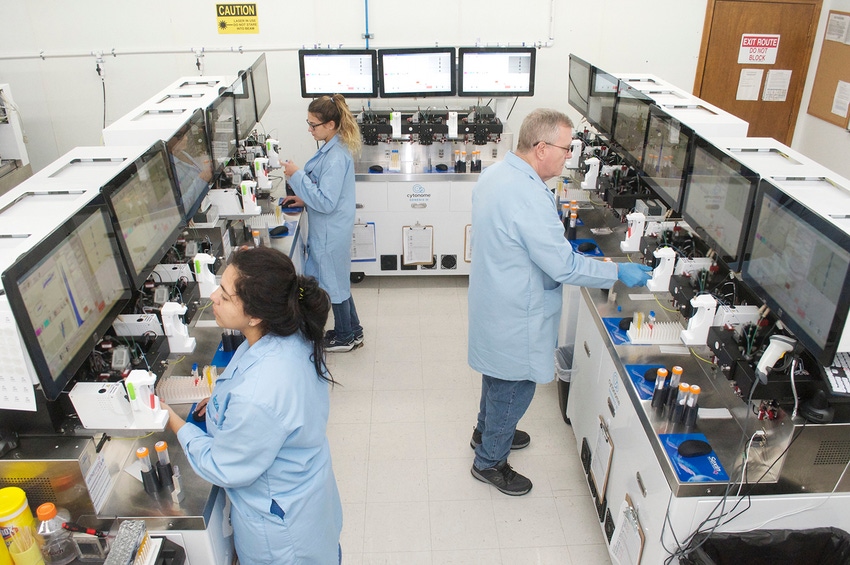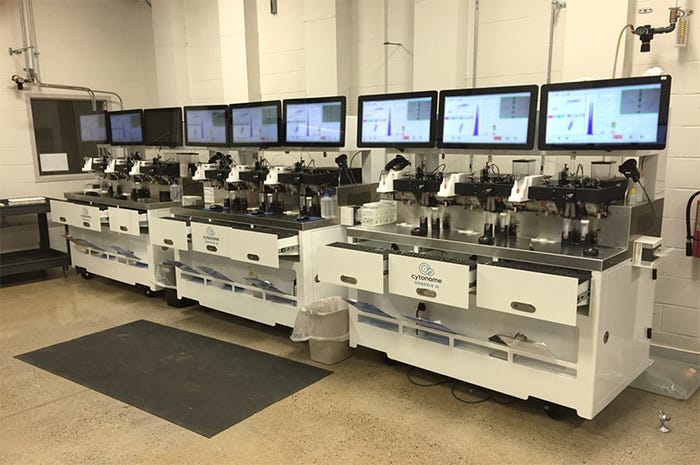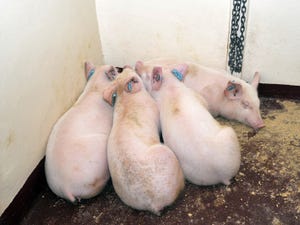Sex-sorted sperm technology can be game changer
Experts feel sex-sorted sperm will be valuable technology in the swine industry, but the true impact depends on the cost of the process.
May 16, 2017

By Treena Hein
Max Rothschild is among many who have no doubt that the commercial availability of 99% sex-sorted sperm would be very valuable to the pork industry in the United States and beyond.
“There might be specific value for some research projects, but mostly for breeding companies at the multiplication phase and for commercial producers,” notes Rothschild, distinguished professor in the Iowa State University department of Agriculture and Life Sciences and the Ensminger Endowed Chair of International Agriculture.
However, Rothschild believes it’s a little early to know the impact on the swine industry as a whole. “The savings will depend on the cost of the process,” he says, “and I don’t know that value.”
Tim Safranski, professor and state swine breeding specialist at the University of Missouri, also sees “clear value” and “lots of potential applications” in technology that’s 99% effective in sorting sperm, provided there are no issues with volume and quality.
“There are benefits obviously in not having to castrate pigs, and the economics get simpler,” he observes. “At the genetic multiplier level, with production of just males or females as preferred, there are lots of efficiencies to be had. At the nucleus level for example, you can scale back the size of your population or maintain it but increase your selection intensity in both males and females.”
For his part, Benny Mote has “always been amazed” at the number of different ways producers have envisioned using high-accuracy sexed sperm. “Some producers claim their perfect operation would consist of raising 100% boars in conjunction with utilizing Improvest to produce the most efficient product available,” says the University of Nebraska assistant professor and swine Extension specialist. “From the standpoint of bacon, barrows offer more product so I can envision some vertically integrated companies pursuing all barrows. If producers want an efficient animal without having to utilize Improvest or castration, those producers would want all gilts.” The commercial value for individual producers in Mote’s view depends on production system, each producer’s view on Improvest and castration, the packer in question and the desires of the consumer.
Mote notes the use of sexed-sorted sperm at the nucleus level isn’t as beneficial as it was just a few years ago. “Before genomics, it was commonplace for breeding companies to randomly pre-select maternal boars early in life, selling a large portion of the remaining males as barrows,” he notes. “Today, breeding companies have the ability to use genomic-enhanced breeding values to allow them to preselect the best boars to remain intact for further testing.”
Mote believes companies will have to carefully think about their use of highly accurate sexed sperm. For example, companies that want more gilts available for nucleus selection-multiplication and therefore reduce males sold as cull boars (needing only a few superior boars to supply enough semen for the breeding pyramid) will also at the same time decrease the number of boars they have to choose from, thus lowering selection intensity.
“For terminal lines, the breeding pyramid is structured differently,” Mote explains. “Furthermore, it is the males that are sold in terminal lines so all boars have typically remained intact from birth to offset and the females do not receive a discount if they are sold as market hogs. Skewing the sex ratio at birth in terminal lines offers more of the saleable product and enhances the selection intensity on the male side, which is usually where a larger percentage of the genetic progress in made.”
Origins of sperm sorting technology
It was in the 1970s that sex separation of sperm based on differences in DNA content (the method used by Fast Genetics and Sexing Technologies) was first developed. Other methods developed since then include the use of bead technologies, centrifugation and detection of sperm surface proteins (the last by Ovasort, a firm affiliated with the United Kingdom’s University of Bristol).
A significant breakthrough was made in 1989, when a team led by Larry Johnson at the USDA Agricultural Research Service in Beltsville, Md., developed a new way to separate sperm based on differences in DNA content. The Beltsville method achieved about 90% success across many livestock species. Later, explains Sexing Technologies’ Chief Operating Officer, Gregg BeVier, the technology was patented by USDA-ARS and licensed to Colorado State University/Research Foundation. “These parties created a company called XY Inc. which Sexing Technologies acquired in 2005,” he says. “Since then, we have refined and commercialized the process, acquiring related businesses and making strong investments in cell sorting, sperm media and low dose insemination techniques.”
Cattle were a natural place to start because the company was already involved in cattle reproduction. Over time, its bull sperm sorting speeds gradually increased and by 2015, Sexing Technologies had achieved fertility rates equivalent to conventional artificial insemination use. Due to advancements in speed tech and the addition of multiple sorter heads per sorting machine, it now provides the cattle industry with highly accurate sex-sorted sperm.
That same year, Sexing Technologies turned to sex sorting of boar sperm, purchasing Fast Genetics in Saskatoon, Saskatchewan, Canada, in the process and experimenting with new media, extenders and the use of low-dose insemination. By 2016, sorting accuracy of 99% had been achieved with what BeVier describes as “industry-acceptable fecundity.”

Addressing questions
Mote wonders if the use of sex-sorted sperm in swine is only practical currently with the use of surgical methods on the sow during fertilization, and believes it is only with the ability to sort large volumes of semen and with the perfection of non-surgical ultra-deep post-cervical AI will Fast Genetics sex-sorting technology ever be a consideration for commercial producers.
In response, Fast Genetics Chief Operating Officer, Shannon Meyers, notes that that sex-sorted sperm will be adopted in combination with lower-dose insemination techniques. “There are both numerous post-cervical and deep uterine as well as other low-dose catheters being actively sold and routinely used in the marketplace,” he explains. “Fast Genetics is currently developing various low-dose catheters to be paired with sex-sorted sperm. Over the last decade, Sexing Technologies has increased sort speeds by over 500%. We own an engineering firm dedicated to creating faster sorters and we foresee that speeds will continue to accelerate.”
Mote also points to research published in January 2016 in the Journal of Animal Science (by Rebecca Winters and David Miller at the University of Illinois in partnership with Sexing Technologies’ scientists Lauren Nettenstrom, Domingo Lopez, Kilby Willenburg and Vish Vishwanath) that showed using sex-sorted sperm reduced the total number of pigs born per insemination. “That will be another hurdle that will need to be cleared,” Mote says, “before there is widespread adoption of the technology at the commercial level.”
Meyers does not think it can be concluded from this research paper that the total number of pigs born would decrease. He adds, “Fast Genetics is putting a huge amount of resources into sex-sorted sperm and we are pleased that it continues to progress, including litter size increases, using low-dose insemination. Furthermore, we are routinely breeding and farrowing sows using a variety of dose catheters and achieving industry-acceptable fecundity rates.”
In terms of specific profit gains that can be achieved through production of a desired gender (for example, through elimination of castration and having to deal with smell issues from intact males, production efficiencies), BeVier says that in a multiplication setting, a farm could theoretically double output of the desired product. In a commercial setting, he expects that a profit gain of $5 to $7 per market hog will be achieved, depending on the sex of the pig, the environment and the jurisdiction. He also thinks worker safety can be better managed if a farm has the option to raise only one gender (by eliminating castration for example).
At this point, the technology is in use at Fast Genetics’ nucleus and multiplier farms, and the company will begin work with its multiplication partners in the next phase. In addition to Saskatchewan, there is one Fast Genetics boar sperm-sorting lab in the United States — in Wisconsin — with new locations to be announced in the future.
You May Also Like



